Lady
Lane / Gracechurch / St Mary at Elms
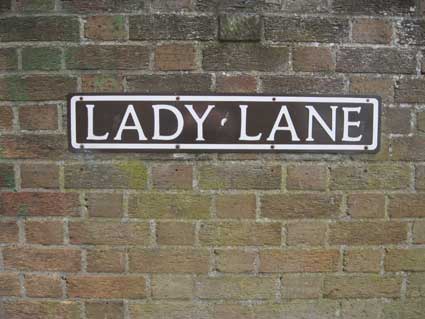
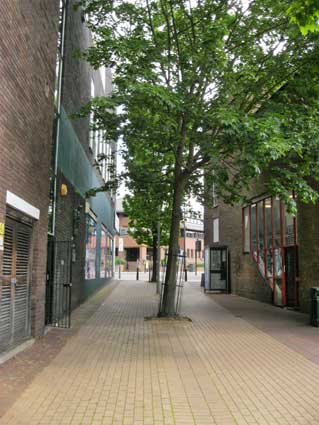 2014 images
2014 images
Once lined by the almshouses built by Wolsey's
uncle Edmund Daundy, Lady Lane as it is today
with the memorial on the wall to the left.
Many
Ipswich residents seem unaware of the historic importance
of the town as a
centre of religious pilgrimage, not to mention religious upheaval (the
latter
symbolised by the Martyrs memorial).
However, one street name recalls that
remote
time. Lady Lane runs between Westgate Street and the top of Black Horse
Lane (Black Horse Walk) and is now a mere passageway. The original
shrine declined and was
eventually dissolved
during
Henry VIII's Reformation purges of Catholic centres (1535-1541); hence
the
disappearance
of the four friaries in Ipswich. The
metal memorial fixed to the modern
brick wall (the outside of Franklins sewing shop)
in
Lady
Lane is supposed to represent the original pre-14th century carved
wooden statue which was
the
object of devotion; the plaque below gives a brief outline of the
history. This likeness is disputed (see the book review below).
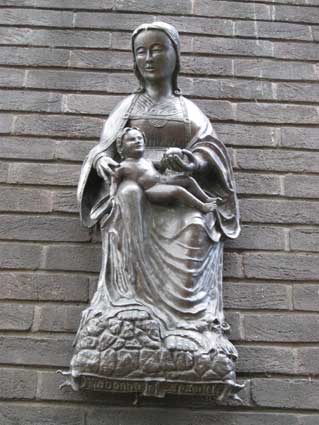
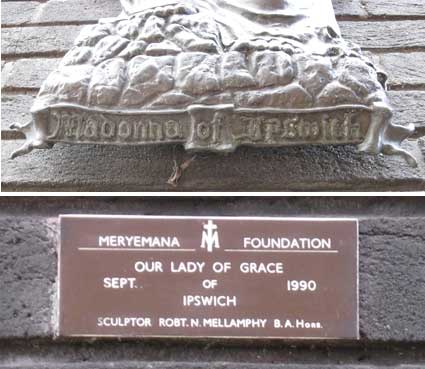
'Madonna
of
Ipswich'
is carved on a scroll in gothic script at the base of
the
statue. Unfortunately
the civic planting of sycamore trees in the lane shades this area in
the summer months. The Borough Council has managed to expunge most of
the graffiti on the brickwork.
Below the fine metal replica of the Madonna by sculptor Robert
Mellamphy
is a small plate:
'MERYMANA FOUNDATION
OUR LADY OF GRACE
SEPT. OF 1990
IPSWICH
SCULPTOR ROBT. N. MELLAMPHY B.A. HONS.'
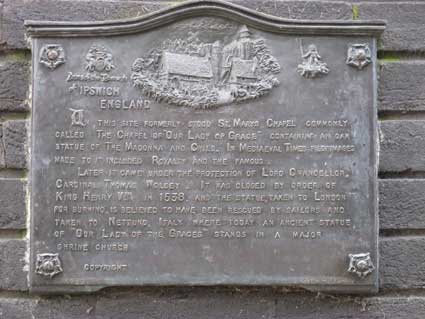 2013 images
2013 images
And then the main commemorative plaque:
'Arms of the Borough of Ipswich England [under crest]
On this site formerly stood St Mary's Chapel commonly called The Chapel
Of "Our Lady Of Grace" containing an oak statue of the Madonna
and Child. In medieval times pilgrimages made to it included Royalty
and
the famous.
Later it came under the protection of The Lord Chancellor, Cardinal
Thomas
Wolsey. It was closed by order of King Henry VIII in 1538 and the
statue,
taken to London for burning, is believed to have been rescued by
sailors
and taken to Nettuno, Italy where today an ancient statue of "Our Lady
Of The Graces" stands in a major shrine church.
Copyright
1989 Robt. N. Mellamphy'
[We hope that the sculptor and Meryemana don't mind us breaking their
copyright
in reproducing this text; after all this wouldn't be much of an
historic
lettering website without it, would it?]
St Mary-At-Elms

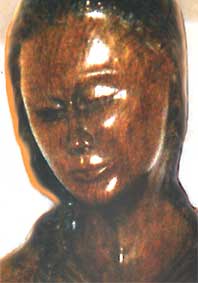 2003 image
2003 image
The shrine to Our Lady of Grace was in recent years
restored
in the nearby (Anglo-Catholic)
St Mary-At-Elms Church in Elm Street.
The replica statue is, again, by Suffolk-based sculptor Robert
Mellamphy, and it was dedicated with great ecumenical
ceremony
in September 2002. The image is a copy of the one at Nettuno in Italy,
which
many people believe to be the rescued statue of Our Lady of Ipswich. If
this is true (see the book review below), one can only imagine the
journey; condemned
to being
burnt
by Protestant reformers, rescued by Catholic adherents and smuggled
from London to
be shipped to the west coast of Italy. The only shame about the wooden
version is that, nestling
in its niche in St Mary-At-Elms, one is unable to see the small
characters from Ipswich
history
which – we are told – the artist has carved on the back of the figure.
This photograph was taken during the first Ip-art festival in 2003.
See our Museum Street
page for 1778 and 1902 comparative maps including this location.
Maps of the area are also on our Civic Drive page.
[UPDATE 4.12.2013]
Reading: Miracles in Lady Lane
 The publication in 2013 of
noted local historian, John Blatchly & Diarmaid MacCulloch: Miracles in Lady Lane (see Reading List) gives a
remarkable insight into a lost pocket of Ipswich history. The book
contains primary research and fascinating hypotheses concerning the
precise location of the lost Shrine of Our Lady of Grace just outside
the town's Westgate
and its fate.
The publication in 2013 of
noted local historian, John Blatchly & Diarmaid MacCulloch: Miracles in Lady Lane (see Reading List) gives a
remarkable insight into a lost pocket of Ipswich history. The book
contains primary research and fascinating hypotheses concerning the
precise location of the lost Shrine of Our Lady of Grace just outside
the town's Westgate
and its fate.
The image on the back cover, an anonymous watercolour painting, and a
photograph (taken around 1875) on the inside back cover are striking. They show the
almshouses built along either side of Lady Lane by Edmund Daundy at
some time before his death in 1515. Daundy happened to be the uncle of
Cardinal Thomas Wolsey the second most powerful person in the country
after the King. These almshouses were on the site of the
14th century St John’s Hospital almshouses built for the poor of the
parish of St Matthew. They adjoined
the shrine chapel which stood just
outside the Westgate (perhaps on the site of today’s haberdashery shop
and QD store on St Matthews Street). The shrine chapel stood on the
site of – or used the same structures as – the chapel of All Saints
which, although not mentioned in Domesday, had early Norman decoration.
Ironically, these ancient, single storey buildings dating back to Tudor
times were demolished as recently as 1877. Look at Lady Lane today and
try to envisage it.
The other notable thing about the shrine is how relatively short-lived
its enormous fame was. All Saints is first mentioned in documents of
1219, but
is certainly earlier, and over time the name changed to the chapel of
'Our Lady of Grace'. On January 8th, 1297 a royal wedding took place in
Ipswich. Princess Elizabeth, daughter of King Edward I, married the
Count of Holland. Edward I stayed in the town for the ceremony with 'a
splendid court'. The wedding took place at the Priory of St Peter and
St Paul, which Henry II founded about 1130. There was clearly a royal
chapel in St Peter's Church at the time of Edward I. It was thought
that the wedding took place, not in any of the parish
churches of the town, but in the Shrine of Our
Lady of Grace, one of England's major shrines
of Marian pilgrimage; this was also referred to in contemporary records
as Our Lady of Ipswich. This royal wedding would have been the earliest
record we
have of a royal occasion at the shrine, but the authors correct the
location in a note within the book. Pilgrims flocked to the shrine in
the ensuing years.
By 1327 documents record the recent discovery of
an image of
the Blessed Virgin, perhaps beneath the flooring of the chapel, and
‘several great miracles had taken place’. Attracting further royal
attention
and becoming prosperous in the 14th and 15th centuries, the chapel of
Our Lady of Grace can be seen as a younger sibling of the Marian shrine
at Walsingham in Norfolk. The scene was set for a ‘miracle’ concerning
the ‘Maid of Ipswich’ in 1516 when the twelve year old daughter of Sir
Roger Wentworth
of Gosfield (twice MP for Ipswich who lived at Thaxted in Essex), in a
tormented state had a vision of the Virgin. She demanded to be taken to
the shrine of Our Lady of Grace in Ipswich and was apparently cured in
a tumultuous fashion.
Her somewhat anarchically pious activities while in Ipswich caused a
great stir and people came to witness them. One notable witness was
that most important resident of the town, Lord
Curson who lived in his mansion on St
Nicholas Street; he wrote down his account of events for the King.
Queen Catherine of Aragon was the next royal superstar to visit the
shrine in 1517, followed by Cardinal Wolsey, papal legate and Lord
Chancellor, the same year – his first major return to his home town
since his rise to great power in the land – and finally by King Henry
VIII himself in 1522. Both royal visitors stayed at Curson House
during their
visits. This patronage meant that it was boom time for the shrine and
a number of hostelries jockeyed for custom from visitors and
pilgrims. At the other end of town The Salutation public house survives
today with its name evoking the Annunciation.
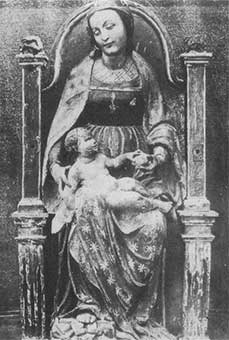
Wolsey’s intention to establish a ‘college’ school to
rival the likes
of Eton College which would be linked to the shrine took
shape around the same time. The Papal Bulls for his Cardinal College
Oxford
were complete by 1526, but those for Cardinal College Ipswich were not
in place until 1528. Opposition to worship of graven images and
idolatry from Lollards, William Tyndale and, locally, the preacher
Thomas Bilney was growing as the shrine became more famous and
prosperous. In 1529 Wolsey was stripped of his government office and
property by Henry VIII, including his magnificently expanded residence
of Hampton Court, which Henry chose to replace the Palace of
Westminster as his own main London residence. However, Wolsey was
permitted to remain Archbishop of York. He travelled to Yorkshire for
the first time in his career, but at Cawood in North Yorkshire, he was
accused of treason and ordered to London by Henry Percy, 6th Earl of
Northumberland. In great distress, he set out for the capital with his
personal chaplain, Edmund Bonner. He fell ill on the journey, and
Thomas Wolsey died at Leicester on 29 November 1530, around the age of
60. The demolition of his half-built Ipswich college – only the Wolsey
Gate in College Street remains
today – was recorded by The Bard:-
'Those twins of learning that he rais'd in you,
Ipswich and Oxford! One of which fell with him,
Unwilling to outlive the good that did it;
The other, though unfinish'd, yet so famous'
(William Shakespeare: Henry VIII)
From 1536 and under Wolsey's former servant, Thomas Cromwell, the
Reformation and establishment of the Church of England progressed;
the first officially-sanctioned bible came in and worshipped images
were
out. Ipswich monasteries were dissolved
along with so many others. The days of the already struggling Ipswich
shrine were numbered
and eventually the building was stripped of valuables and building
materials. Evidence of its existence seems to have survived until the
mid-18th century.
The seductive conspiracy theory that the Ipswich sculpture wasn't burnt
at Chelsea, but smuggled from London by Catholic sailors and taken to
Italy is dismissed by the authors of Miracles in Lady Lane out of hand. The style of the carving
of the image in Nettuno is much later than the statue of the Virgin
which
was rediscovered in the Lady Lane shrine chapel by 1327 (see the image
of the Madonna in Nettuno at the right). Also, those
involved in the purging of idolatry from Cromwell downwards knew the
importance of the removal of the image and its public burning;
the
failure to do so seems very unlikely.
This book is a fine addition to the rich roller-coaster of the history
of
Ipswich.
We have much more on Wolsey's College.
Search Ipswich
Historic Lettering
©2004 Copyright
throughout the Ipswich
Historic Lettering site: Borin Van Loon
No reproduction of text or images without express written permission
 2013 images
2013 images




 2003 image
2003 image The publication in 2013 of
noted local historian, John Blatchly & Diarmaid MacCulloch:
The publication in 2013 of
noted local historian, John Blatchly & Diarmaid MacCulloch: 